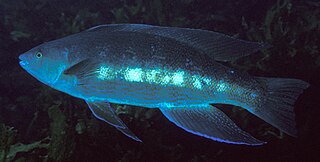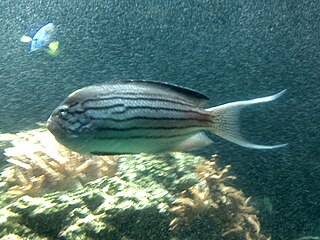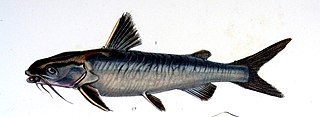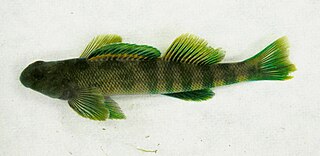
Pomacanthus is a genus of marine angelfish that is usually found around reefs and coral. Some of the notable places one can see these vari-coloured fish includes the Maldives, Sri Lanka, and Sipidan off the southern coast of Sabah, Malaysia. Generally the patterns and colors of these fish undergo a major transformation from juvenile to adult forms. The juveniles may even appear to be a different species.

Holacanthus is a genus of marine angelfishes. The eight species are particularly abundant near volcanic rocks and coral islands. Some are highly valued as food, but even more so for aquaria, as all are brightly colored.

The Odacidae are a small family of ray-finned fishes formerly classified within the order Perciformes, commonly known as cales, and weed whitings. They are related to the much larger families of the wrasses and parrotfish. More recent workers have classified this family within the order Labriformes, alongside the wrasses and parrotfishes, within the clade Percomorpha.

The Japanese angelfish or Japanese pygmy angelfish is a species of marine ray-finned fish, a marine angelfish belonging to the family Pomacanthidae. It is found in the western Pacific Ocean.

Cheilinus is a genus of fish in the family Labridae native to the Indian and Pacific Ocean.

Forcipiger is a genus of fish in the family Chaetodontidae, the butterflyfishes. It is distributed throughout the Indo-Pacific region. The name of this genus means “bearing forceps” and is a reference to the long, slender snouts of the species in this genus.

Chaetodontoplus is a genus of marine angelfishes in the family Pomacanthidae. The are found in the Indo-Pacific region.

Genicanthus is a genus of marine angelfishes in the family Pomacanthidae. Known commonly as swallowtail or lyretail angelfish, these fishes are so-named for the distinctive shape of their tailfins. This genus of angels, in comparison to the other species found in hobby aquaria, are a good choice for beginners as they do not get nearly as large as some of the others. Another unique attribute is that swallowtail angels will tolerate each other and can be kept in pairs or as a single male with a harem, though it is typically best to add them to a tank at the same time. If added on by one, the angel which is added first may become aggressively territorial towards any new additions. Unlike others in the family Pomocanthidae, the angelfish species in the genus Genicanthus are generally considered to be reef safe. Also unlike most other members of the Pomacanthidae, those in Genicanthus are sexually dimorphic, meaning males and females are easily distinguishable. Fish in this species possess a small mouth relative to its size. This small mouth is well adapted for feeding on plankton in the water column. As planktivores, members of Genicanthus generally will not nip corals and sessile invertebrates.
Ladigesocypris mermere, also known as the Izmir minnow, is a species of ray-finned fish in the family Cyprinidae. It is found only in Turkey. Its natural habitats are rivers, intermittent rivers, and freshwater springs. It is threatened by habitat loss. Ladigesocypris irideus is the other member of the genus according to Fishbase.

The banded angelfish, also known as the bandit angelfish and three spine angelfish, is a distinctive species ray-finned fish belonging to the family Pomacanthidae. It is endemic to deeper reefs in Hawaii and the Johnston Atoll.

Apolemichthys xanthurus, the Indian yellowtail angelfish, is a species of marine angelfish belonging to the family Pomacanthidae. Other common names include cream angelfish, smoke angelfish, and yellowtail black angelfish. It is found in the Indian Ocean.

Apolemichthys griffisi, or Griffis angelfish, is a species of ray-finned fish, a marine angelfish belonging to the family Pomacanthidae. It is found in the Pacific Ocean. It is a rarity for the species to enter the aquarium trade.
Centropyge venusta, the purplemask angelfish is a species of marine ray-finned fish, a marine angelfish belonging to the family Pomacanthidae, It is found in the Western Pacific and is occasionally found the aquarium trade.
Ophthalmolebias ilheusensis is a killifish from the family Rivulidae which is endemic to Brazil where it is only known from river floodplains near Ilhéus in Bahia. Fishbase has this as the only species in the genus Opthamolebias with the other five species which other authorities classify as being within that genus placed in Simpsonichthys. The genus Ophthalmolebias was initially considered a subgenus of Simpsonichthys, but has been elevated to full genus status.

Pseudocaranx is a genus of ray-finned fishes from the family Carangidae, the jacks, trevallies, scads and pompanos. They occurs in the western Atlantic Ocean and in the Indo-Pacific.

Apolemichthys trimaculatus, the threespot angelfish or flagfin angelfish, is a demersal marine ray-finned fish, a marine angelfish belonging to the family Pomacanthidae. It has a wide Indo-Pacific distribution.
Centropyge nox, known commonly as the midnight angelfish or dusky angelfish, is a species of marine ray-finned fish, a marine angelfish belonging to the family Pomacanthidae. It is found in the Western Pacific Ocean.

Apolemichthys xanthotis, the yellow-ear angelfish or Red Sea angelfish, is a species of marine ray-finned fish, a marine angelfish belonging to the family Pomacanthidae.

The White sea catfish, also called the Marine catfish, is a species of catfish in the family Ariidae. It was described by Bernard Germain de Lacépède in 1803, originally under the genus Pimelodus. It is an oceanodromous species that is found between the Río de la Plata Basin and eastern Brazil. It reaches a maximum total length of 120 cm (47 in). It has been recorded spawning between the months of August–December. The maximum known life expectancy is 36 years.

Etheosomatidae is a species rich subfamily of freshwater ray-finned fish, the members of which are commonly known as the darters. The subfamily is part of the family Percidae which also includes the perches, ruffes and pikeperches. The family is endemic to North America. It consists of 3-5 different genera and well over 200 species.
























